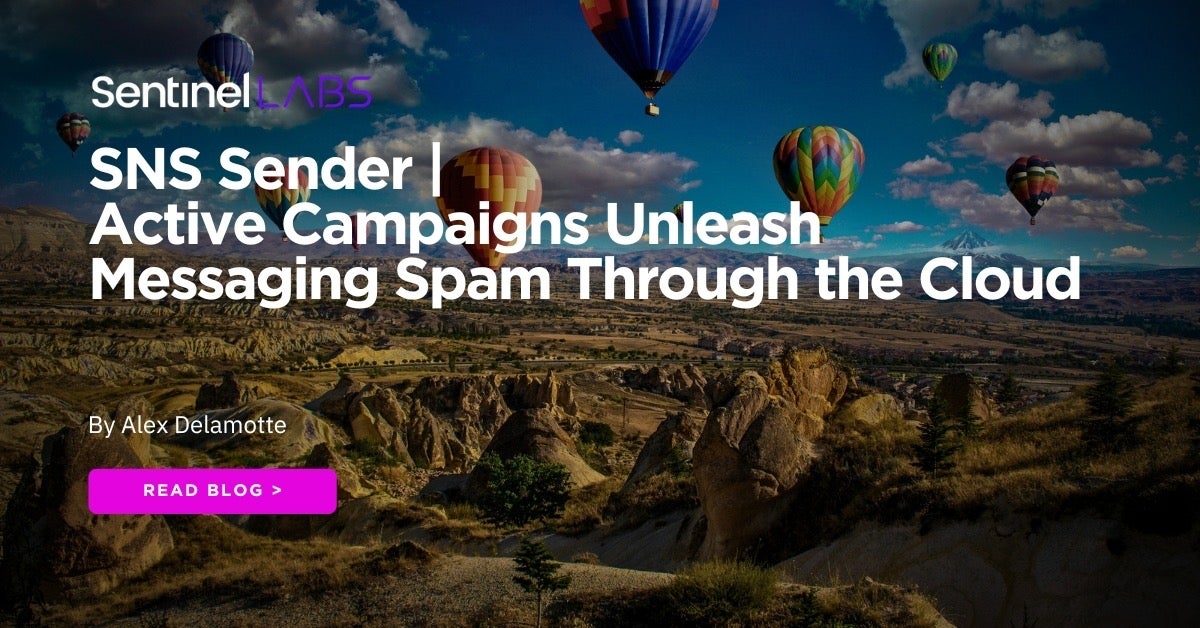AWS SNS Topic Created by Rare User
Identifies when an SNS topic is created by a user who does not typically perform this action. Adversaries may create SNS topics to stage capabilities for data exfiltration or other malicious activities. This is a New Terms rule that only flags when this behavior is observed for the first time by a user or role.
Elastic rule (View on GitHub)
1[metadata]
2creation_date = "2025/02/11"
3integration = ["aws"]
4maturity = "production"
5updated_date = "2025/09/09"
6
7[rule]
8author = ["Elastic"]
9description = """
10Identifies when an SNS topic is created by a user who does not typically perform this action. Adversaries may create SNS
11topics to stage capabilities for data exfiltration or other malicious activities. This is a New Terms rule that only flags
12when this behavior is observed for the first time by a user or role.
13"""
14false_positives = [
15 """
16 Legitimate users may create SNS topics for legitimate purposes. Ensure that the creation is authorized before taking
17 action.
18 """,
19]
20from = "now-6m"
21index = ["filebeat-*", "logs-aws.cloudtrail-*"]
22language = "kuery"
23license = "Elastic License v2"
24name = "AWS SNS Topic Created by Rare User"
25note = """## Triage and Analysis
26
27### Investigating AWS SNS Topic Created by Rare User
28
29This rule detects the creation of an AWS Simple Notification Service (SNS) topic by a user who does not typically perform this action. Adversaries may create SNS topics to facilitate data exfiltration or other malicious activities.
30
31This is a [New Terms](https://www.elastic.co/guide/en/security/current/rules-ui-create.html#create-new-terms-rule) rule that only flags when this behavior is observed for the first time by a user or role.
32
33#### Possible Investigation Steps
34
35### Identify the Actor and Context
36- **User Identity and Role**:
37 - Examine `aws.cloudtrail.user_identity.arn` to determine **who** created the SNS topic.
38 - Identify whether the actor assumed a **privileged IAM role** (`aws.cloudtrail.user_identity.type: "AssumedRole"`) or used a long term access keys (`aws.cloudtrail.user_identity.access_key_id`).
39- **User Agent and Tooling**:
40 - Check `user_agent.original` to determine if this action was performed via the AWS CLI, SDK, or Console.
41 - If `aws-cli` was used, review whether it aligns with typical automation or administrative behavior.
42- **Source IP and Geographic Location**:
43 - Review `source.ip` and `source.geo` fields to confirm if the request originated from a **trusted** or **unexpected** location.
44
45### Evaluate the SNS Topic Creation
46- **Topic Name and Purpose**:
47 - Check `aws.cloudtrail.request_parameters` for the **SNS topic name** and determine whether it appears suspicious (e.g., random strings, unusual keywords).
48- **Target Region and Account**:
49 - Verify `cloud.region` and `cloud.account.id` to **ensure the SNS topic was created in an expected environment**.
50- **Associated API Calls**:
51 - Identify additional actions **before or after** this event using `event.action` values like:
52 - `Subscribe`
53 - `Publish`
54 - `SetTopicAttributes`
55 - These may indicate follow-up steps taken to misuse the SNS topic.
56
57### Analyze Potential Malicious Intent
58- **Is This an Isolated Action or a Pattern?**
59 - Check if this **user has previously created SNS topics** using historical CloudTrail logs.
60 - Look for **multiple topic creations in a short period**, which may suggest an automation script or malicious behavior.
61- **Unusual Role Usage**:
62 - If `aws.cloudtrail.user_identity.arn` references an **EC2 instance role**, verify whether that instance typically performs SNS operations.
63- **Potential Data Exfiltration or Persistence**:
64 - Review whether **new subscriptions** were added (`Subscribe` API action) to forward data externally.
65 - If an SNS topic was configured to trigger **Lambda functions or S3 events**, it may indicate an attempt to persist in the environment.
66
67## False Positive Analysis
68- **Legitimate Usage of SNS**:
69 - SNS is commonly used for **event-driven notifications** in AWS.
70 - Check whether the SNS topic creation aligns with known **DevOps, automation, or monitoring activities**.
71- **Routine IAM Role Activity**:
72 - If the user typically interacts with SNS, consider **allowlisting** expected IAM roles for this action.
73- **AWS Services Creating Topics Automatically**:
74 - Some AWS services may **auto-create SNS topics** for alerts and monitoring. Confirm whether the creation was system-generated.
75
76## Response and Remediation
77- **Confirm Authorization**:
78 - If the user was not expected to create SNS topics, verify whether their IAM permissions should be restricted.
79- **Revoke Unauthorized Access**:
80 - If unauthorized, disable the access keys or IAM role associated with the event.
81- **Monitor for Further SNS Modifications**:
82 - Set up additional monitoring for **SNS Publish or Subscription events** (`Publish`, `Subscribe`).
83- **Enhance IAM Policy Controls**:
84 - Consider enforcing **least privilege** IAM policies and enabling **multi-factor authentication (MFA)** where applicable.
85- **Investigate for Persistence**:
86 - Check whether the SNS topic is **being used as a notification channel for Lambda, S3, or other AWS services**.
87"""
88references = [
89 "https://docs.aws.amazon.com/sns/latest/api/API_CreateTopic.html",
90 "https://permiso.io/blog/s/smishing-attack-on-aws-sms-new-phone-who-dis/",
91 "https://www.sentinelone.com/labs/sns-sender-active-campaigns-unleash-messaging-spam-through-the-cloud/",
92]
93risk_score = 21
94rule_id = "3c3f65b8-e8b4-11ef-9511-f661ea17fbce"
95severity = "low"
96tags = [
97 "Domain: Cloud",
98 "Data Source: AWS",
99 "Data Source: Amazon Web Services",
100 "Data Source: AWS SNS",
101 "Resources: Investigation Guide",
102 "Use Case: Threat Detection",
103 "Tactic: Resource Development",
104 "Tactic: Impact",
105]
106timestamp_override = "event.ingested"
107type = "new_terms"
108
109query = '''
110event.dataset: "aws.cloudtrail"
111 and event.provider: "sns.amazonaws.com"
112 and event.action: "CreateTopic"
113 and event.outcome: "success"
114'''
115
116
117[[rule.threat]]
118framework = "MITRE ATT&CK"
119[[rule.threat.technique]]
120id = "T1608"
121name = "Stage Capabilities"
122reference = "https://attack.mitre.org/techniques/T1608/"
123
124
125[rule.threat.tactic]
126id = "TA0042"
127name = "Resource Development"
128reference = "https://attack.mitre.org/tactics/TA0042/"
129[[rule.threat]]
130framework = "MITRE ATT&CK"
131[[rule.threat.technique]]
132id = "T1496"
133name = "Resource Hijacking"
134reference = "https://attack.mitre.org/techniques/T1496/"
135[[rule.threat.technique.subtechnique]]
136id = "T1496.004"
137name = "Cloud Service Hijacking"
138reference = "https://attack.mitre.org/techniques/T1496/004/"
139
140
141[rule.threat.tactic]
142id = "TA0040"
143name = "Impact"
144reference = "https://attack.mitre.org/tactics/TA0040/"
145
146[rule.investigation_fields]
147field_names = [
148 "@timestamp",
149 "user.name",
150 "user_agent.original",
151 "source.ip",
152 "aws.cloudtrail.user_identity.arn",
153 "aws.cloudtrail.user_identity.type",
154 "aws.cloudtrail.user_identity.access_key_id",
155 "event.action",
156 "event.outcome",
157 "cloud.account.id",
158 "cloud.region",
159 "aws.cloudtrail.request_parameters",
160 "aws.cloudtrail.response_elements"
161]
162[rule.new_terms]
163field = "new_terms_fields"
164value = ["cloud.account.id", "user.name"]
165[[rule.new_terms.history_window_start]]
166field = "history_window_start"
167value = "now-10d"
Triage and Analysis
Investigating AWS SNS Topic Created by Rare User
This rule detects the creation of an AWS Simple Notification Service (SNS) topic by a user who does not typically perform this action. Adversaries may create SNS topics to facilitate data exfiltration or other malicious activities.
This is a New Terms rule that only flags when this behavior is observed for the first time by a user or role.
Possible Investigation Steps
Identify the Actor and Context
- User Identity and Role:
- Examine
aws.cloudtrail.user_identity.arnto determine who created the SNS topic. - Identify whether the actor assumed a privileged IAM role (
aws.cloudtrail.user_identity.type: "AssumedRole") or used a long term access keys (aws.cloudtrail.user_identity.access_key_id).
- Examine
- User Agent and Tooling:
- Check
user_agent.originalto determine if this action was performed via the AWS CLI, SDK, or Console. - If
aws-cliwas used, review whether it aligns with typical automation or administrative behavior.
- Check
- Source IP and Geographic Location:
- Review
source.ipandsource.geofields to confirm if the request originated from a trusted or unexpected location.
- Review
Evaluate the SNS Topic Creation
- Topic Name and Purpose:
- Check
aws.cloudtrail.request_parametersfor the SNS topic name and determine whether it appears suspicious (e.g., random strings, unusual keywords).
- Check
- Target Region and Account:
- Verify
cloud.regionandcloud.account.idto ensure the SNS topic was created in an expected environment.
- Verify
- Associated API Calls:
- Identify additional actions before or after this event using
event.actionvalues like:SubscribePublishSetTopicAttributes
- These may indicate follow-up steps taken to misuse the SNS topic.
- Identify additional actions before or after this event using
Analyze Potential Malicious Intent
- Is This an Isolated Action or a Pattern?
- Check if this user has previously created SNS topics using historical CloudTrail logs.
- Look for multiple topic creations in a short period, which may suggest an automation script or malicious behavior.
- Unusual Role Usage:
- If
aws.cloudtrail.user_identity.arnreferences an EC2 instance role, verify whether that instance typically performs SNS operations.
- If
- Potential Data Exfiltration or Persistence:
- Review whether new subscriptions were added (
SubscribeAPI action) to forward data externally. - If an SNS topic was configured to trigger Lambda functions or S3 events, it may indicate an attempt to persist in the environment.
- Review whether new subscriptions were added (
False Positive Analysis
- Legitimate Usage of SNS:
- SNS is commonly used for event-driven notifications in AWS.
- Check whether the SNS topic creation aligns with known DevOps, automation, or monitoring activities.
- Routine IAM Role Activity:
- If the user typically interacts with SNS, consider allowlisting expected IAM roles for this action.
- AWS Services Creating Topics Automatically:
- Some AWS services may auto-create SNS topics for alerts and monitoring. Confirm whether the creation was system-generated.
Response and Remediation
- Confirm Authorization:
- If the user was not expected to create SNS topics, verify whether their IAM permissions should be restricted.
- Revoke Unauthorized Access:
- If unauthorized, disable the access keys or IAM role associated with the event.
- Monitor for Further SNS Modifications:
- Set up additional monitoring for SNS Publish or Subscription events (
Publish,Subscribe).
- Set up additional monitoring for SNS Publish or Subscription events (
- Enhance IAM Policy Controls:
- Consider enforcing least privilege IAM policies and enabling multi-factor authentication (MFA) where applicable.
- Investigate for Persistence:
- Check whether the SNS topic is being used as a notification channel for Lambda, S3, or other AWS services.
References
Related rules
- AWS SNS Topic Message Publish by Rare User
- Excessive AWS S3 Object Encryption with SSE-C
- AWS DynamoDB Scan by Unusual User
- AWS DynamoDB Table Exported to S3
- AWS SSM Session Started to EC2 Instance

